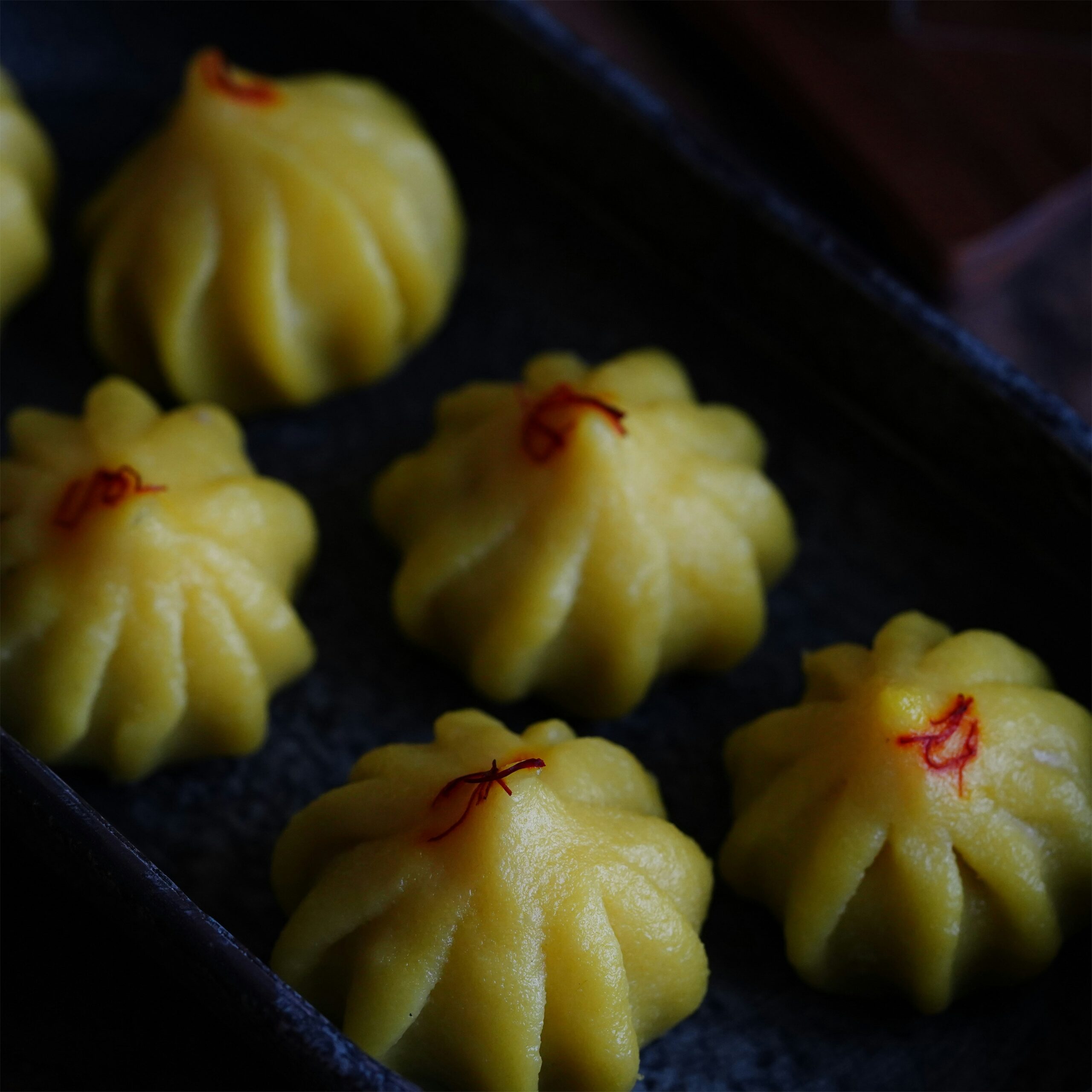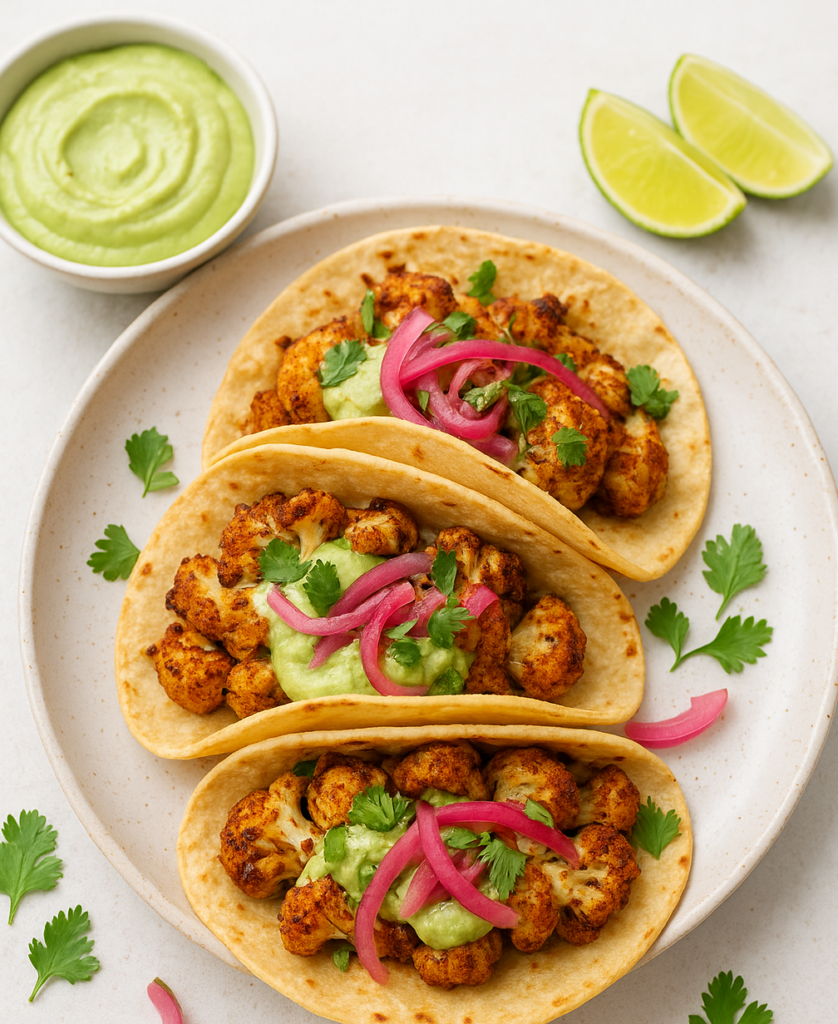Step 1: Prepare the Filling
- Heat a pan and add 1 tsp ghee.
- Roast poppy seeds lightly until they release aroma. (Optional but enhances flavor.)
- Add grated coconut and sauté on medium flame for 1–2 minutes.
- Now add grated jaggery and mix well. The jaggery will start melting.
- Cook until the mixture thickens slightly (do not overcook, or it will harden).
- Add cardamom powder and dry fruits, mix well.
- Remove from heat and let it cool completely.
🔑 Tip: The filling should be moist but not watery, otherwise the Modaks may break.
Step 2: Make the Dough (Ukad)
- Boil 1 ¼ cup water in a pan. Add 1 tsp ghee and a pinch of salt.
- Reduce the flame and add rice flour gradually, stirring continuously to avoid lumps.
- Cover the pan and let it steam for 2–3 minutes on low flame.
- Switch off the heat and allow it to cool slightly.
- While still warm, grease your palms with ghee and knead the dough until smooth and soft.
🔑 Tip: The dough must be kneaded while warm; otherwise, it will crack while shaping.
Step 3: Shape the Modaks
- Grease your palms with ghee.
- Take a lemon-sized ball of dough and flatten it into a small disc.
- Shape it into a small cup using your fingers, thinning the edges gently.
- Place 1–2 tsp of the coconut-jaggery filling inside.
- Carefully pleat the edges and bring them together to form a conical peak at the top.
🔑 Tip: If shaping is difficult, you can use a Modak mould for perfect shapes.
Step 4: Steam the Modaks
- Grease a steamer plate or line it with banana/turmeric leaves for fragrance.
- Arrange the Modaks neatly, leaving little space between them.
- Steam for 10–15 minutes on medium flame until the outer covering turns shiny and translucent.
✨ Serving
- Place the Modaks on a plate, drizzle with ghee, and offer to Lord Ganesha first as prasad.
- Serve warm and enjoy the heavenly taste!
🌼 Variations of Modak
- Fried Modak (Talniche Modak): Deep-fried with wheat flour covering for a crispy texture.
- Dry Fruit Modak: Made with khoya (mawa), nuts, and dates for a rich taste.
- Chocolate Modak: A modern twist loved by kids, made with cocoa or melted chocolate.
💛 Emotional & Cultural Touch
For devotees, Modak is not just a sweet but a sacred offering. The soft shell symbolizes purity and simplicity, while the sweet filling stands for inner joy and spiritual wisdom. Preparing Modaks together is a ritual of love, family bonding, and devotion, making Ganesh Chaturthi celebrations complete.
🌺 Modak and the Spirit of Ganesh Chaturthi
Ganesh Chaturthi is one of the most vibrant and widely celebrated festivals in India, honoring Lord Ganesha, the remover of obstacles and the harbinger of wisdom, prosperity, and good fortune. The air fills with chants of “Ganpati Bappa Morya”, homes are adorned with flowers and lights, and families come together in devotion. Among all offerings made to Lord Ganesha, Modak holds a special, divine significance. It is believed to be Bappa’s favorite sweet, a symbol of love, purity, and bliss.
🌸 The Legend of Modak
According to Hindu mythology, once Lord Shiva and Goddess Parvati offered young Ganesha a divine sweet called Modak. Upon eating it, Ganesha declared it his most beloved food. Since then, Modak has been associated with him, and devotees prepare it during Ganesh Chaturthi as an offering. Tradition says offering 21 Modaks pleases Lord Ganesha and brings happiness, health, and prosperity into the devotee’s life.
The Modak also carries a deeper spiritual meaning. The soft outer shell represents the human body, while the sweet filling inside symbolizes inner joy, wisdom, and the sweetness of devotion. Thus, eating or offering a Modak is not just about taste—it is about embracing the bliss of inner contentment.
✨ Cultural and Emotional Value
In Maharashtra, Goa, and many other parts of India, the preparation of Ukadiche Modak (steamed Modaks) is a family ritual. Women gather in the kitchen, laughter fills the air, and every fold of the Modak carries love and devotion. Children eagerly wait for the first bite of this melt-in-the-mouth prasad. More than just food, Modak embodies tradition, togetherness, and faith passed down through generations.
The festival itself, Ganesh Chaturthi, was popularized during India’s freedom movement by Lokmanya Bal Gangadhar Tilak, who encouraged people to celebrate it publicly to bring unity among Indians. Since then, Ganesh Chaturthi has grown from a household ritual to a grand public festival, with idols ranging from small clay figurines to massive installations worshipped by entire communities.
🌺 Modak and the Spirit of Ganesh Chaturthi
Ganesh Chaturthi is one of the most vibrant and widely celebrated festivals in India, honoring Lord Ganesha, the remover of obstacles and the harbinger of wisdom, prosperity, and good fortune. The air fills with chants of “Ganpati Bappa Morya”, homes are adorned with flowers and lights, and families come together in devotion. Among all offerings made to Lord Ganesha, Modak holds a special, divine significance. It is believed to be Bappa’s favorite sweet, a symbol of love, purity, and bliss.
🌸 The Legend of Modak
According to Hindu mythology, once Lord Shiva and Goddess Parvati offered young Ganesha a divine sweet called Modak. Upon eating it, Ganesha declared it his most beloved food. Since then, Modak has been associated with him, and devotees prepare it during Ganesh Chaturthi as an offering. Tradition says offering 21 Modaks pleases Lord Ganesha and brings happiness, health, and prosperity into the devotee’s life.
The Modak also carries a deeper spiritual meaning. The soft outer shell represents the human body, while the sweet filling inside symbolizes inner joy, wisdom, and the sweetness of devotion. Thus, eating or offering a Modak is not just about taste—it is about embracing the bliss of inner contentment.
✨ Cultural and Emotional Value
In Maharashtra, Goa, and many other parts of India, the preparation of Ukadiche Modak (steamed Modaks) is a family ritual. Women gather in the kitchen, laughter fills the air, and every fold of the Modak carries love and devotion. Children eagerly wait for the first bite of this melt-in-the-mouth prasad. More than just food, Modak embodies tradition, togetherness, and faith passed down through generations.
The festival itself, Ganesh Chaturthi, was popularized during India’s freedom movement by Lokmanya Bal Gangadhar Tilak, who encouraged people to celebrate it publicly to bring unity among Indians. Since then, Ganesh Chaturthi has grown from a household ritual to a grand public festival, with idols ranging from small clay figurines to massive installations worshipped by entire communities.

MODAK


No responses yet